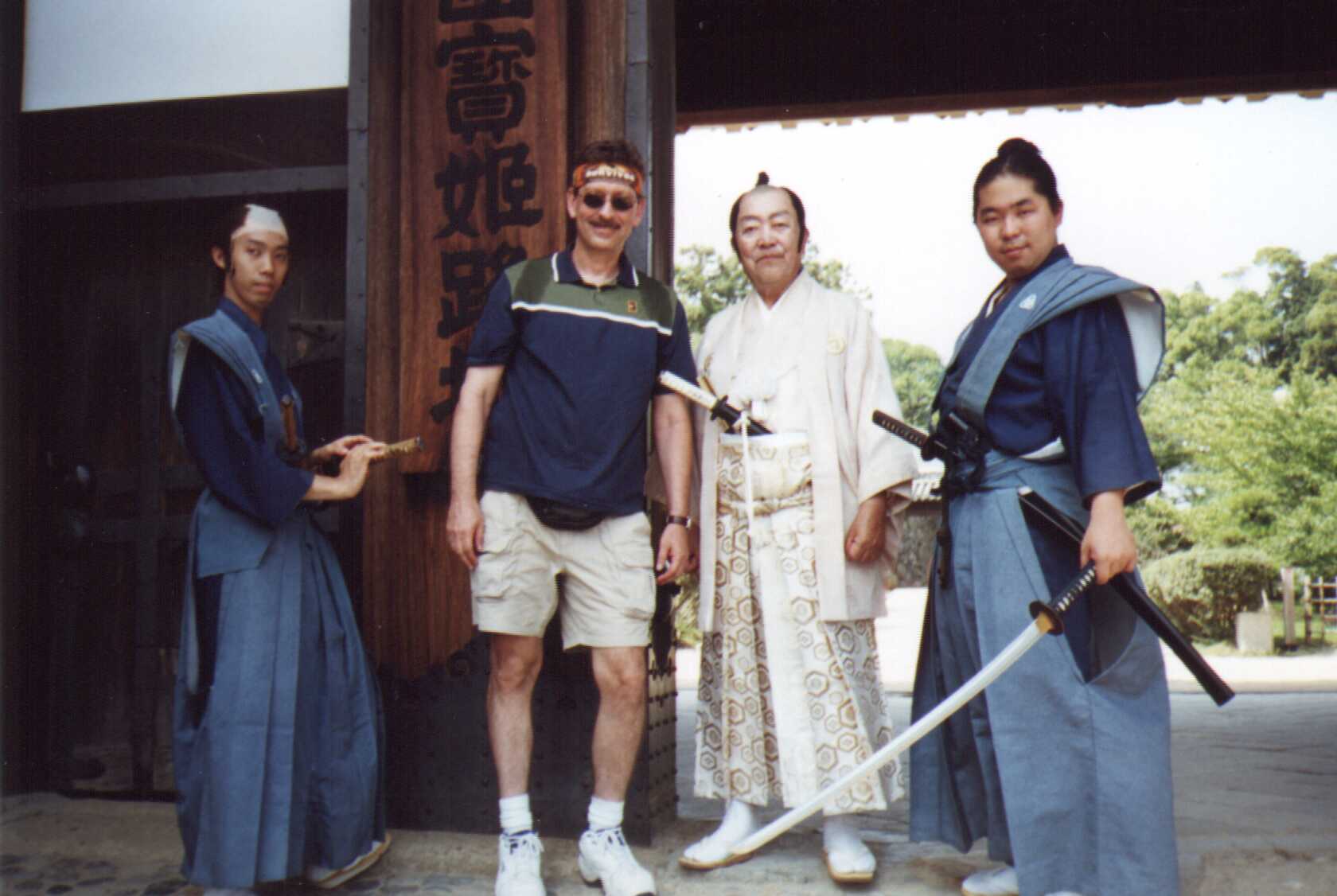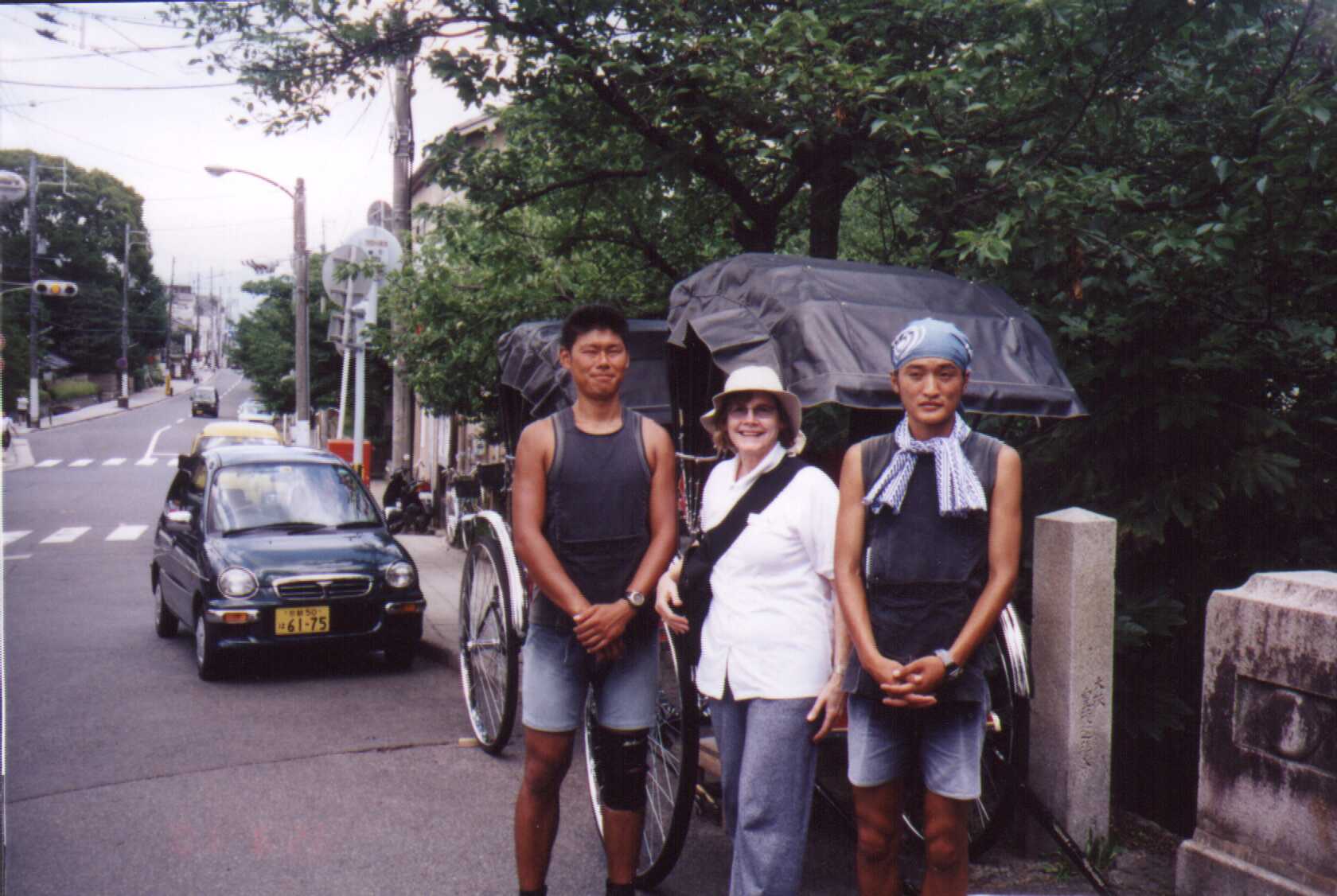 The
sense of being in another land was immediate as teachers from
Edison/Fareira
High School set foot in Kobe, Japan. The striking change from the
hustle and bustle of our city life was in stark contrast to the peace
and
serenity that was evident all around. Thus began an enlightening,
educational experience this summer as these educators embarked on their
journey to study the history, culture, and language of Japan.
Teachers
Mr. Stanley Markuszka and Mrs. Suzanne Corvin, along with school
librarian,
Dr. Evelyn Bender, traveled as part of the Greater Philadelphia
“Philadelphia-Nipponica”
Project funded by the United States - Japan Foundation. The
program
was designed to increase an awareness and understanding of Japan. The
sense of being in another land was immediate as teachers from
Edison/Fareira
High School set foot in Kobe, Japan. The striking change from the
hustle and bustle of our city life was in stark contrast to the peace
and
serenity that was evident all around. Thus began an enlightening,
educational experience this summer as these educators embarked on their
journey to study the history, culture, and language of Japan.
Teachers
Mr. Stanley Markuszka and Mrs. Suzanne Corvin, along with school
librarian,
Dr. Evelyn Bender, traveled as part of the Greater Philadelphia
“Philadelphia-Nipponica”
Project funded by the United States - Japan Foundation. The
program
was designed to increase an awareness and understanding of Japan.
Participants attended six weekend seminars at the University of Pennsylvania during the previous school year to prepare for their trip. Classes were offered in the history and culture of Japan with some language instruction to provide the group necessary survival and communication skills. The teachers will prepare units to share with the staff and students to foster a better understanding of life in Japan. The intensive three week excursion included forty-two scheduled visits. The group traveled to the cities of Kobe, Kyoto, Himeji, Hiroshima, Tokyo, and Sendai. A series of visits to local schools and Sophia University showed vast differences in the educational systems of the United States and Japan. The itinerary also took the group to various temples, museums, lectures, the U.S. Embassy, Japanese Foreign Ministry, national television studio, and social events. The highlight for each participant was the homestay with a host family. Mr. Markuszka is the Social
Studies Department
chairperson at Edison and organized the school’s contingency
plan.
He was awed by his The tropical temperature made the
stay
somewhat uncomfortable. People regularly carried umbrellas and
hand
towels to protect themselves from the intense heat. The homestay
did not afford the comfort of air conditioning of the hotels. For
that reason, there is a lot of social activity. Young and old
engage
in all types of events outside of the home and return to eat and sleep.
Many aspects of everyday life in terms of business and economics would be challenging for most Americans. Workers are devoted to the country and the corporation. The strict design of the corporate structure allows minimal individual creativity and little to no diversity. Free spirits who think out of the box tend to move to other countries to pursue their talents elsewhere. Cities tend to cater to the business community as opposed to the tourist trade. Extended travel in many cities is cost prohibitive as evidenced by the high price of food, hotel rooms, and clothing. Another surprising aspect of Japanese life is the prevalence of modern cars. Inspection fees of $1,000 are imposed on cars over five years old. Used vehicles are then exported to China and Korea.
The time spent with her host family was particularly enjoyable. Corvin recounted the special treatment she received and how she felt honored to be in the home. The family escorted her around the city to shop and visit rice paddies. She also appreciated the small gifts of a fan and glass bowl that the family so generously offered. She noted the strong sense of religion both in and out of the home. A Shinto shrine was located in the house as a place to pray for the safety of the family. Although Shinto and Buddhism are Japan’s two main religions, many are practiced simultaneously. Different faiths are practiced at different stages of life. For example, Buddhism may be the favored choice of service for a wedding where someone may prefer to have a Shinto funeral. Corvin also noted the dedication to the history and culture of the land. Hiroshima’s Peace Memorial Park is filled with paper cranes sent by thousands of students. The cranes are in honor of a little girl named Sadako who struggled with the aftereffects of the atomic bomb dropped by United States forces in 1945. Each crane is made as a wish to one’s good health in case of illness. A service is held annually in memory of all of the victims. The beauty and cleanliness of Japan made quite an impression on Dr. Bender. She witnesses a reverence for and respect of nature in the attention to detail of the parks and gardens and explained that an air of freshness permeated the surroundings. There was always a feeling of security and she especially enjoyed this during her early morning walks. She often encountered friendly people who would stop to engage her in conversation. Students particularly asked questions of foreigners often as part of academic assignments.
Bender was also impressed by the dedication to mastering a craft. It is not uncommon for someone to spend ten years or more learning the intricacies of making fabric or pottery or perfecting the art of the tea ceremony. Working with bunraku puppets is labor intensive at best. It takes ten years to learn to move one part and thirty years to master the puppet. The follow-up lessons are now in the planning stages. The participants returned with interesting books, pictures, videos, and artifacts to share. Edison teachers will receive staff development to use the materials in their own classes across the curriculum. Planned activities include projects in art, baking and food service, a library reference section, teaching about the people through literature, and using audio-visual materials. The students will also have a chance to learn through the personal anecdotes of each participant. As we are now particularly sensitive to world relationships due to our recent national tragedy of September 11th, hopefully, everyone will gain a better understanding and appreciation of the diverse world in which we live. |
 experiences and described many instances of culture shock which ranged
from educational to humorous. He was most surprised by the size
of
things as his head repeatedly made contact upon entering buses and his
knees hit tables when seated. Markuszka noted the respect for the
environment and sense of security everywhere. There was no litter
on the streets and smokers even carried individual ashtrays to discard
the waste of their habit. It was also a pleasure to walk
around
without unsightly graffiti as streets are regularly adorned with
beautiful
plants or floral arrangements. The sense of mankind is
evident
as Japanese people enjoy a low crime rate. People treating each
other
with maximum respect is a lifestyle. There is a low police
presence
and school age children walk the streets at all hours without
fear.
experiences and described many instances of culture shock which ranged
from educational to humorous. He was most surprised by the size
of
things as his head repeatedly made contact upon entering buses and his
knees hit tables when seated. Markuszka noted the respect for the
environment and sense of security everywhere. There was no litter
on the streets and smokers even carried individual ashtrays to discard
the waste of their habit. It was also a pleasure to walk
around
without unsightly graffiti as streets are regularly adorned with
beautiful
plants or floral arrangements. The sense of mankind is
evident
as Japanese people enjoy a low crime rate. People treating each
other
with maximum respect is a lifestyle. There is a low police
presence
and school age children walk the streets at all hours without
fear.  Mrs.
Corvin was truly amazed first and foremost by the extreme honesty of
the
people. Having suffered the misfortune of leaving her camera on a
train, she knew that she would never see it again. The lady of
the
house of her host family made a call to the train station and to
Corvin’s
surprise the camera had been turned in to the lost and found.
This
gave her a new appreciation for the human spirit and awareness of the
willingness
and desire of people to help one another.
Mrs.
Corvin was truly amazed first and foremost by the extreme honesty of
the
people. Having suffered the misfortune of leaving her camera on a
train, she knew that she would never see it again. The lady of
the
house of her host family made a call to the train station and to
Corvin’s
surprise the camera had been turned in to the lost and found.
This
gave her a new appreciation for the human spirit and awareness of the
willingness
and desire of people to help one another.  Bender
also described the importance of a good education. One particular
school ranges from K-Ph.D. where attendance is considered an
honor.
Education is highly valued and a large emphasis is placed on higher
education.
Students take rigorous examinations to gain entry into high school with
a reputation of getting its graduates into the best universities.
Although a large number of students attend college much of the prestige
is gained upon enrollment. With the knowledge that job interviews
can be secured on the basis of the name of the university, many
students
devote much of their college time to extracurricular activities.
As men are considered the wage earners of the family, higher education
opportunities are in their favor. Things are very slowly changing
for women who still are victimized by the glass ceiling.
Bender
also described the importance of a good education. One particular
school ranges from K-Ph.D. where attendance is considered an
honor.
Education is highly valued and a large emphasis is placed on higher
education.
Students take rigorous examinations to gain entry into high school with
a reputation of getting its graduates into the best universities.
Although a large number of students attend college much of the prestige
is gained upon enrollment. With the knowledge that job interviews
can be secured on the basis of the name of the university, many
students
devote much of their college time to extracurricular activities.
As men are considered the wage earners of the family, higher education
opportunities are in their favor. Things are very slowly changing
for women who still are victimized by the glass ceiling.